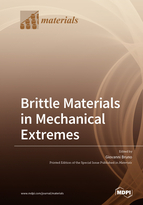Brittle Materials in Mechanical Extremes
A special issue of Materials (ISSN 1996-1944).
Deadline for manuscript submissions: closed (31 October 2019) | Viewed by 31576
Special Issue Editor
Interests: neutron diffraction; residual stress; mechanical properties of materials; additive manufacturing; porous ceramics
Special Issues, Collections and Topics in MDPI journals
Special Issue Information
Dear Colleagues,
Brittle materials include a wide range of material classes: From polymers to metals, through classic glass, ceramics, and composites. They all share a supposed linear elastic behavior, but are often found to display non-linear stress–strain relationships, as well as high temperature dilation (or other properties). In this Special Issue, contributions describing and explaining this intriguing behavior, whether due to microcracking, interaction among constituent phases, or micro-structural features, are welcome. Advanced characterization techniques, challenging numerical and analytical models, as well unconventional experiments should be reported and spark the debate about the origin of the behavior of brittle materials under mechanical extremes.
The description of the mechanical behavior of brittle materials under operational (sometimes unconventional) loads, such as mechanical and temperature cycling, electric fields, corrosion environments, represents one of the focuses of the Special Issue. The discussion of analogies and differences between different materials, such as polymers and concrete, represent another focus of the issue (e.g., plasticity vs. microcracking). Modeling and rationalization of peculiar behaviors of brittle materials will be another focus of the issue.
All should be corroborated by advanced microstructural studies (microscopy, 3D imaging, etc.), leading to the identification of the microstructure–property relationships.
The grand goal is to provide an overview, through different aspects, of unconventional or unexpected reaction of brittle materials to external (mechanical, thermal, chemical, etc.) loads, at all temperatures of interest, including cryogenic.
Prof. Dr. Giovanni BrunoGuest Editor
Manuscript Submission Information
Manuscripts should be submitted online at www.mdpi.com by registering and logging in to this website. Once you are registered, click here to go to the submission form. Manuscripts can be submitted until the deadline. All submissions that pass pre-check are peer-reviewed. Accepted papers will be published continuously in the journal (as soon as accepted) and will be listed together on the special issue website. Research articles, review articles as well as short communications are invited. For planned papers, a title and short abstract (about 100 words) can be sent to the Editorial Office for announcement on this website.
Submitted manuscripts should not have been published previously, nor be under consideration for publication elsewhere (except conference proceedings papers). All manuscripts are thoroughly refereed through a single-blind peer-review process. A guide for authors and other relevant information for submission of manuscripts is available on the Instructions for Authors page. Materials is an international peer-reviewed open access semimonthly journal published by MDPI.
Please visit the Instructions for Authors page before submitting a manuscript. The Article Processing Charge (APC) for publication in this open access journal is 2600 CHF (Swiss Francs). Submitted papers should be well formatted and use good English. Authors may use MDPI's English editing service prior to publication or during author revisions.
Keywords
- Ceramics
- Concrete
- Composites
- non-linear behavior
- anelasticity
- microcracking
- mechanical properties
- high-temperature
- micromechanical modeling
- FEM
- in-situ testing







